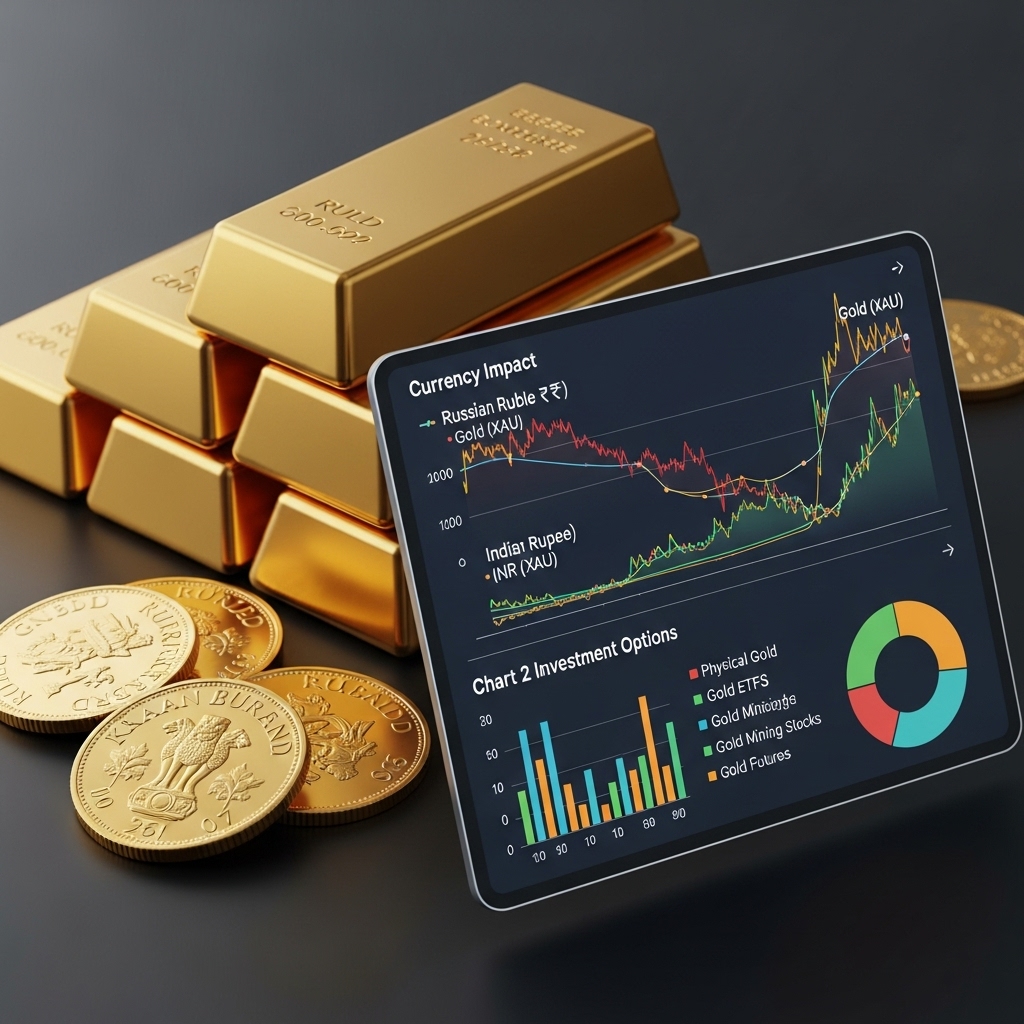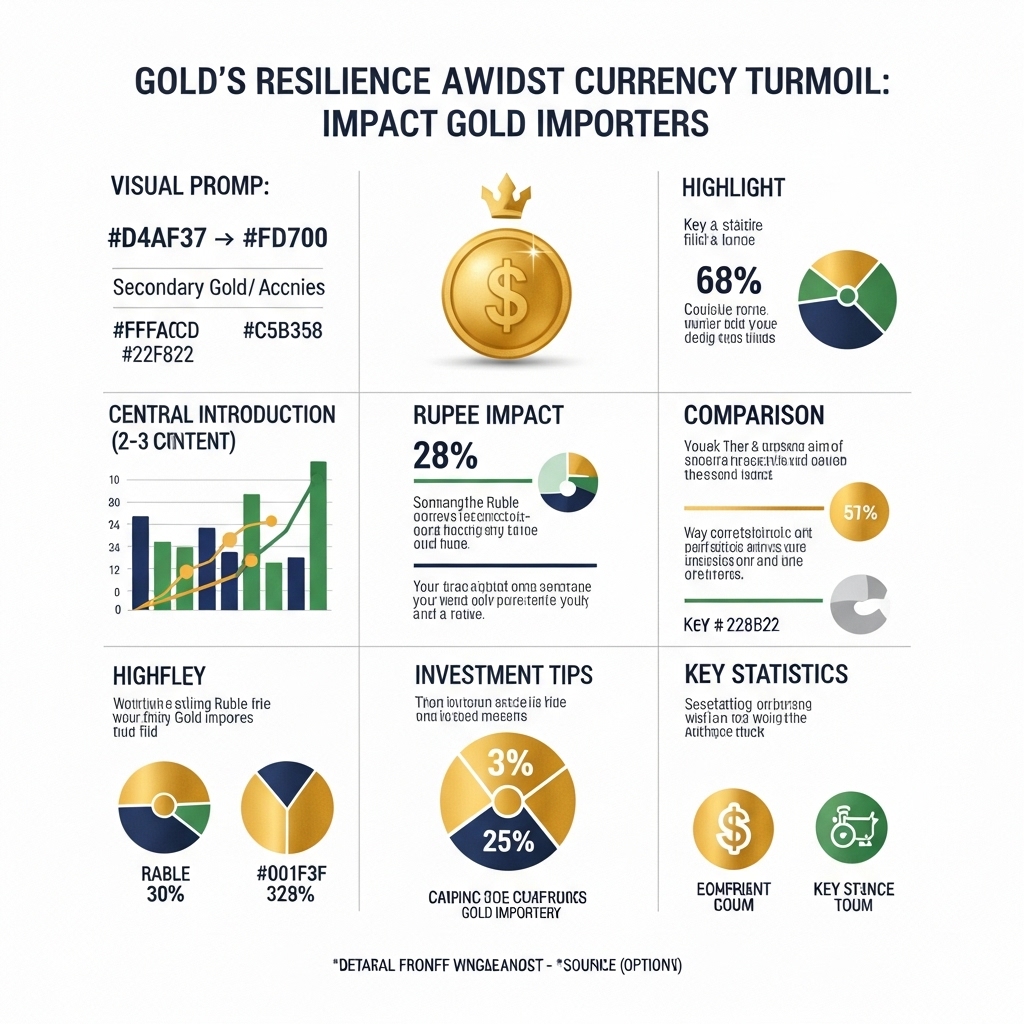Navigating Currency Volatility: Opportunities for Gold Importers
Gold has long stood as a beacon of stability in turbulent times, and its recent performance amidst global economic shifts continues to capture the attention of astute investors. While the allure of rising gold prices often dominates headlines, a less discussed yet equally critical factor influencing gold’s true value for many is currency strength. As the Russian Ruble experiences significant depreciation and the Indian Rupee grapples with its own weakening trends, a unique and complex scenario unfolds for gold importers in these crucial markets. Understanding these currency dynamics isn’t just an academic exercise; it’s a direct path to identifying strategic opportunities and mitigating risks within your gold investment portfolio.
For gold importers, the direct impact of a weaker local currency is profound: it translates to higher costs when purchasing dollar-denominated gold, potentially eroding profit margins and altering market demand. However, these currency shifts also create intricate market trends that savvy investors can leverage. This volatility can lead to re-evaluation of local gold pricing, stimulate domestic demand for physical gold as a hedge against inflation, and even influence global gold flow. Recognising how these macro-economic forces translate into tangible financial benefits or challenges is paramount for anyone serious about capitalising on the gold market.
In this comprehensive overview, we will delve into the intricate relationship between a falling Ruble, a weakening Rupee, and their specific implications for gold importers. We’ll explore the mechanics of how currency depreciation affects import costs, examine the resulting market trends, and uncover the potential financial benefits and strategic adjustments that importers and investors can consider. Prepare to gain insights into how these currency movements reshape the landscape of gold trading, offering a clearer path to optimising your gold investment strategies.
Gold Market Analysis and Key Insights
The depreciation of currencies like the Russian Ruble and Indian Rupee against the US Dollar significantly impacts the gold market, particularly for importers and domestic investors. While a weaker local currency means imported gold becomes more expensive in local terms, it simultaneously amplifies gold’s appeal as a critical investment asset.
Increased Safe-Haven Demand
A falling Ruble and Rupee often signal underlying economic vulnerabilities or geopolitical uncertainties within their respective regions. In such environments, gold traditionally shines as a safe-haven asset. Investors seek its stability to preserve wealth and hedge against currency devaluation, driving up local demand despite higher prices. This trend is exacerbated by global instability, high inflation, and persistent central bank gold accumulation, all contributing to gold’s current resilience near all-time highs.
Inflation Hedge and Wealth Preservation
Weakening currencies inherently lead to higher import costs and domestic inflation. Gold historically serves as an excellent hedge against inflation, safeguarding purchasing power when fiat currencies lose value. For investors in Russia and India, allocating to gold offers a tangible store of value, protecting their portfolios from the erosive effects of rising prices and currency depreciation.
Investment Benefits and Considerations
Investing in gold during periods of currency weakness offers diversification against currency risk and a reliable store of value. It acts as a counter-cyclical asset to traditional financial instruments, providing portfolio stability. However, investors must consider the local premium paid due to the weaker currency, storage costs for physical gold, and market volatility. While gold offers stability, it does not generate income like dividends or interest.
Expert Recommendations: Financial advisors often recommend a strategic allocation to gold as part of a diversified portfolio, especially during economic uncertainty. For long-term wealth preservation, dollar-cost averaging into gold-backed instruments like Gold ETFs or physical bullion can mitigate price volatility. It is crucial for investors to understand their risk tolerance and investment horizon before making significant allocations.

Gold Investment Strategies and Options
For gold importers navigating a falling ruble and weak rupee, a strategic approach to investment is paramount. Beyond simply importing physical gold, various investment avenues exist, each with its own risk-reward profile.
Diversified Gold Holdings: Investors can consider a mix of physical gold (bullion, coins), gold ETFs (Exchange Traded Funds), and gold mining stocks. Gold ETFs offer liquidity and lower transaction costs compared to physical gold, while mining stocks provide exposure to the yellow metal with the added leverage of company performance.
Hedging Strategies: To mitigate currency risk associated with imports, importers can explore currency futures and options. These derivatives allow for locking in exchange rates, providing a degree of certainty for future transactions and safeguarding profit margins against adverse currency movements.
Risk Assessment and Portfolio Allocation: A thorough risk assessment is crucial. Consider the volatility of both gold prices and currency exchange rates. A prudent portfolio allocation would balance gold holdings with other assets to diversify risk. For instance, an investor might allocate 10-20% of their portfolio to gold, adjusting based on their risk tolerance and market outlook.
Comparison of Investment Methods:
* Physical Gold: High intrinsic value, tangible asset, but incurs storage and insurance costs, and can be illiquid.
* Gold ETFs: Liquid, lower costs, diversified, but dependent on underlying ETF management and subject to market fluctuations.
* Gold Mining Stocks: Potential for higher returns due to leverage, but carries company-specific and operational risks.
* Currency Derivatives: Effective for hedging, but complex and require expertise to manage.
Market Timing: While difficult to predict, considering geopolitical events, inflation trends, and central bank policies can inform timing decisions. A weakening local currency can make gold imports more expensive in the short term, but if the rupee continues to depreciate, the long-term value of gold held in dollars could appreciate when converted back. Importers should monitor global economic indicators and central bank statements closely.
Market Performance and Outlook
Historically, gold’s performance in local currencies like the Russian Ruble (RUB) and Indian Rupee (INR) has inversely tracked their strength against the US Dollar. For instance, the Ruble’s sharp depreciations in 2014 and 2022 led to significant surges in local gold prices, making imports considerably more expensive for Russian buyers. Similarly, the Rupee’s gradual but consistent weakening over the past decade has steadily increased the INR cost of gold, even when international dollar prices remained relatively stable. This translates directly into higher landed costs for gold importers in both nations.
Currently, both the Ruble and Rupee remain under pressure. The Ruble faces ongoing volatility due to geopolitical tensions, sanctions, and fluctuating oil revenues. The Rupee contends with global interest rate differentials, trade deficits, and foreign institutional investor outflows. Concurrently, international gold prices are influenced by the US Federal Reserve’s monetary policy, global inflation outlooks, and geopolitical risks, often acting as a safe-haven asset.
Looking ahead, a sustained weak Ruble is anticipated due to structural economic challenges, suggesting continued high local gold prices. The Rupee is also expected to experience a slow but steady depreciation against the dollar, implying further increases in INR gold import costs. Key economic factors like US interest rate trajectory, inflation, and the US dollar index will dictate international gold prices. For importers, persistent currency weakness means navigating significantly higher procurement costs in local currency terms, potentially dampening domestic demand and squeezing profit margins.
Frequently Asked Questions About Gold Investment
How do falling ruble and weak rupee affect gold importers?
When currencies weaken against the US dollar, gold importers face higher procurement costs since gold is priced in dollars. Importers must pay more local currency to purchase the same amount of gold, squeezing profit margins and potentially leading to higher consumer prices.
Why does currency depreciation make gold more expensive for importers?
Gold is internationally traded in US dollars. When the ruble or rupee loses value, importers need more local currency units to buy equivalent dollar amounts of gold, directly increasing their import costs and reducing purchasing power.
What impact do weak currencies have on gold demand?
Higher import costs often translate to increased retail gold prices, which can dampen consumer demand. However, some investors view gold as a hedge against currency instability, potentially boosting investment demand during weak currency periods.
How do importers manage currency risk in gold trading?
Gold importers typically use hedging strategies like forward contracts, currency swaps, or options to protect against adverse exchange rate movements and stabilize procurement costs.
Should investors worry about currency fluctuations affecting gold prices?
While short-term currency volatility can impact local gold prices, gold’s intrinsic value as a store of wealth generally offsets temporary currency-related price swings over the long term.

Final Thoughts on Gold Investment
In essence, a depreciating Ruble and a weakening Rupee fundamentally alter the landscape for gold importers, making gold more expensive in local currency terms. For investors, this scenario highlights gold’s intensified role as a crucial safe haven and inflation hedge against currency erosion and economic instability. While the immediate import costs are higher, the underlying demand for gold as a store of value in these regions often strengthens, driven by a flight to safety.
Our final recommendation for gold investors is to view gold not just as a commodity, but as a strategic asset for portfolio diversification, especially in times of significant currency volatility. It can act as a robust buffer against economic headwinds. Therefore, we urge you to continue monitoring global economic indicators and currency movements closely. Evaluate gold’s potential to fortify your portfolio; consult with a trusted financial advisor to make informed decisions that align with your long-term financial goals.